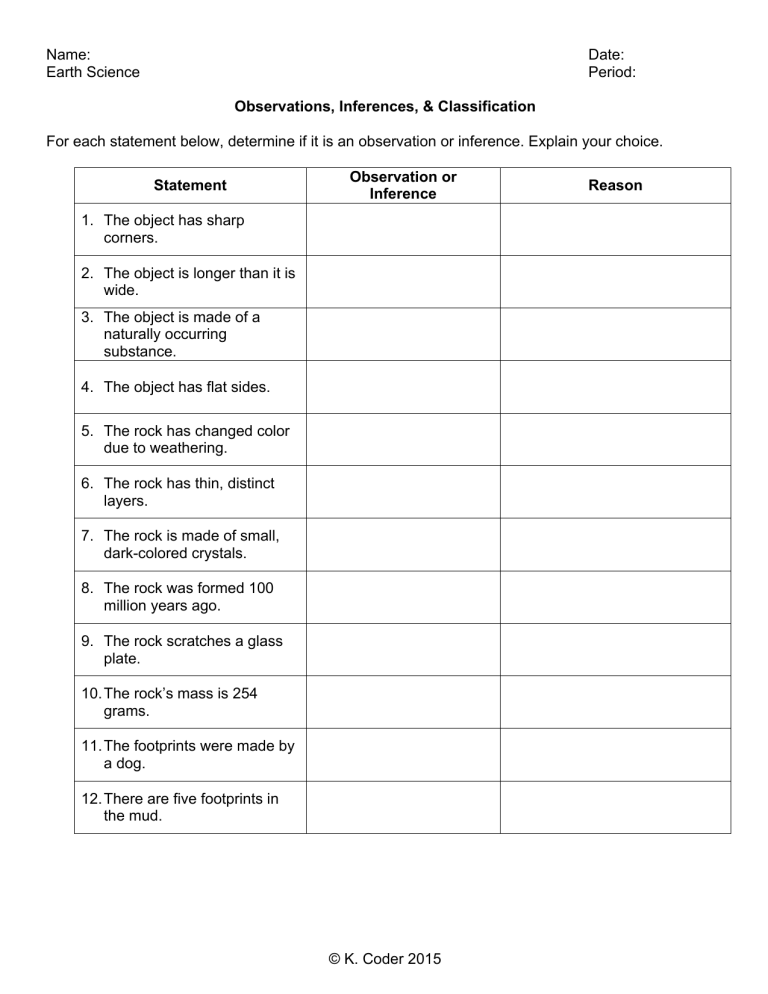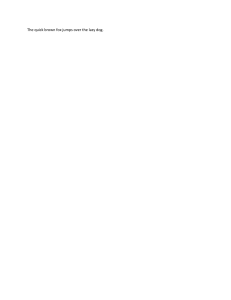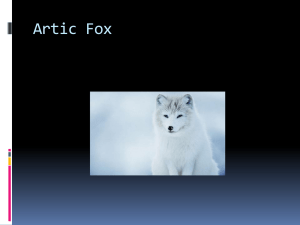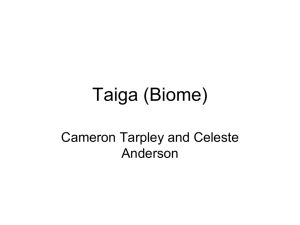Earth Science: Observations, Inferences, Classification Worksheet
advertisement

Name: Earth Science Date: Period: Observations, Inferences, & Classification For each statement below, determine if it is an observation or inference. Explain your choice. Statement Observation or Inference 1. The object has sharp corners. 2. The object is longer than it is wide. 3. The object is made of a naturally occurring substance. 4. The object has flat sides. 5. The rock has changed color due to weathering. 6. The rock has thin, distinct layers. 7. The rock is made of small, dark-colored crystals. 8. The rock was formed 100 million years ago. 9. The rock scratches a glass plate. 10. The rock’s mass is 254 grams. 11. The footprints were made by a dog. 12. There are five footprints in the mud. © K. Coder 2015 Reason 13. In order to make observations, an observer must always use a) experiments b) the senses c) proportions d) mathematical calculations 14. Using a ruler to measure the length of a stick is an example of a) extending the sense of sight by using an instrument b) calculating the percent of error by using a proportion c) measuring the rate of change of the stick by making inferences d) predicting the length of the stick by guessing 15. The drawing below shows an arctic fox. Which statement is an observation of the arctic fox in the drawing? a) The arctic fox has two ears. b) The arctic fox eats mice during the summer. c) The arctic fox lives farther north than other types of foxes. d) The arctic fox has fur that changes color during the winter. 16. An extinct animal called a mammoth is shown below. Which statement is an observation about the mammoth? a) The mammoth was related to the elephant. b) The mammoth was a slow-moving animal. c) The mammoth’s tusks were used for protection. d) The mammoth’s tusks were curved and pointed. © K. Coder 2015 17. The tracks below were made by a dinosaur. Scientists can conclude by studying these track that this dinosaur a) could not fly b) could not swim c) walked using one leg d) walked using two legs 18. According to the picture, which of these is an inference rather than an observation? a) This animal has hair. b) This animal has a tail. c) This animal is arching its back. d) This animal is frightened. 19. The primary purpose of a classification system is to enable people to a) make measurements that are very accurate b) eliminate inaccurate inferences c) organize observations in a meaningful way d) extend their powers of observation 20. A classification system is based on the use of a) the human senses to observe properties of objects b) instruments to observe properties of objects c) observed properties to group objects with similar characteristics d) inferences to make observations 21. Which procedure is an example of classifying observed data? 1) grouping stars by brightness 2) graphing temperature versus time for a particular date 3) photographing the cloud cover for a location throughout 1 week 4) measuring the angle of Polaris from two different locations © K. Coder 2015 22. A student observed two objects and made a list of information describing each object. Which properties of the objects did the student most likely observe and describe in each list? a) shape, color, and length b) shape, length, and temperature c) size, color, and texture d) size, temperature, and color Base your answers to questions 23 and 24 on the four animals shown below. 23. Classify these animals into two different groups. Group 1 Group 2 24. Explain why you grouped the animals into these two groups. © K. Coder 2015



